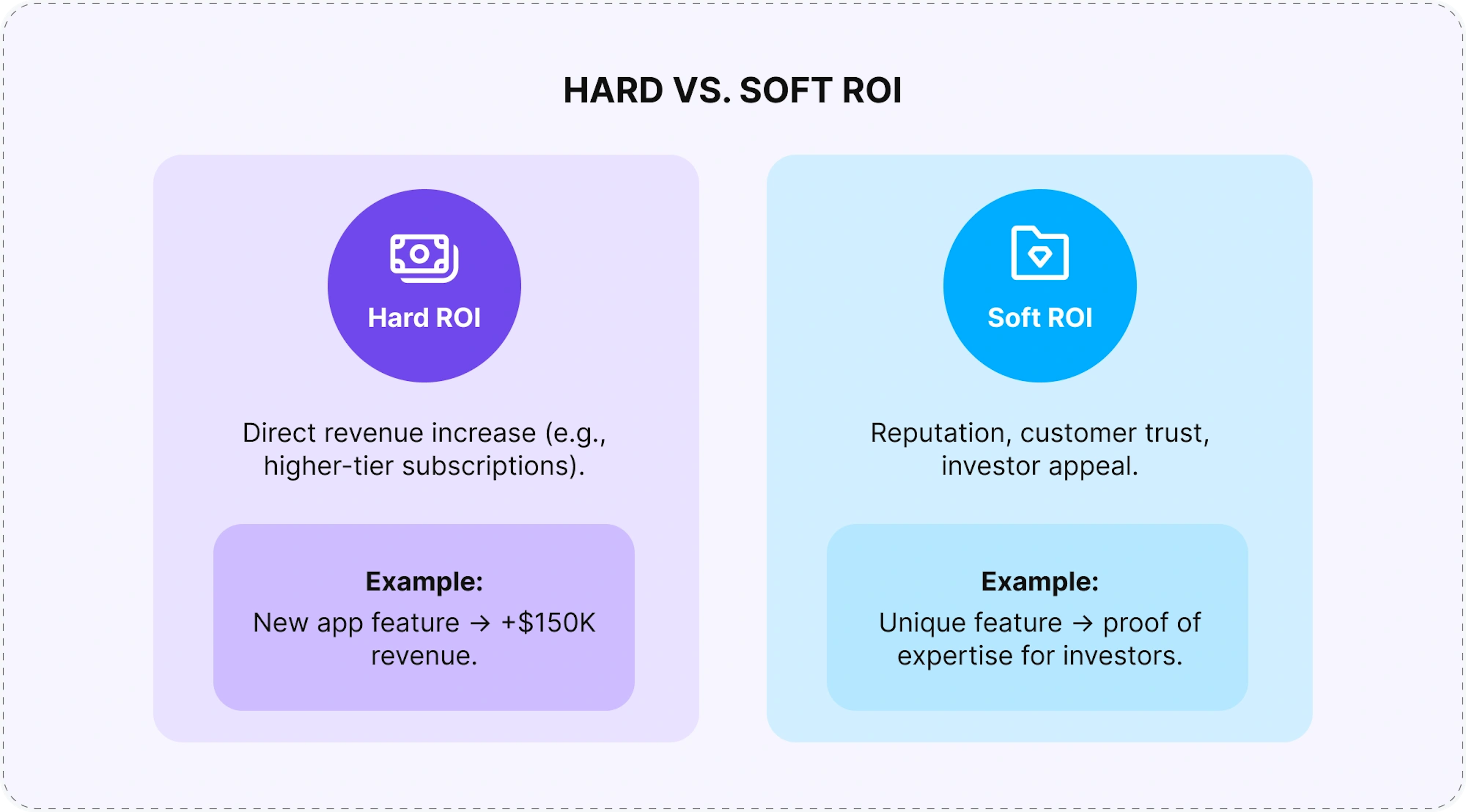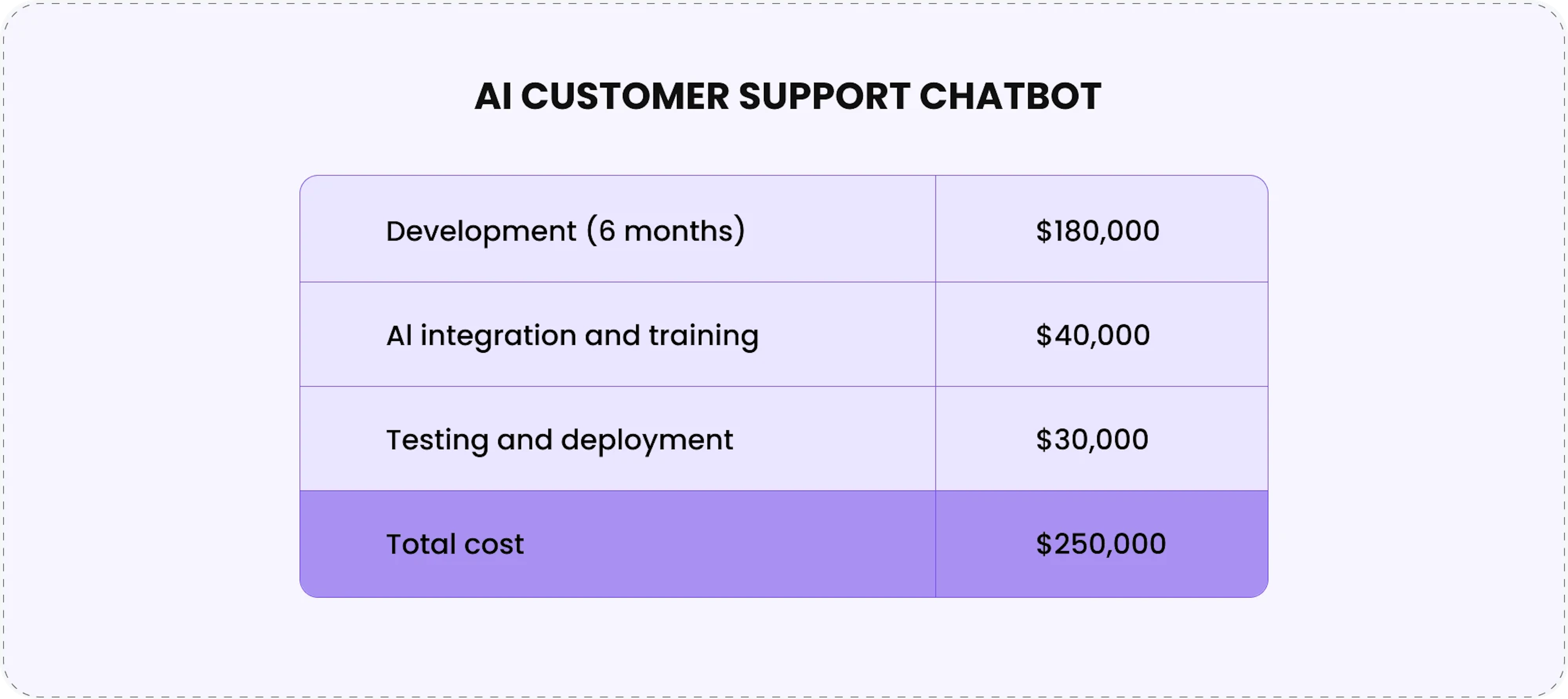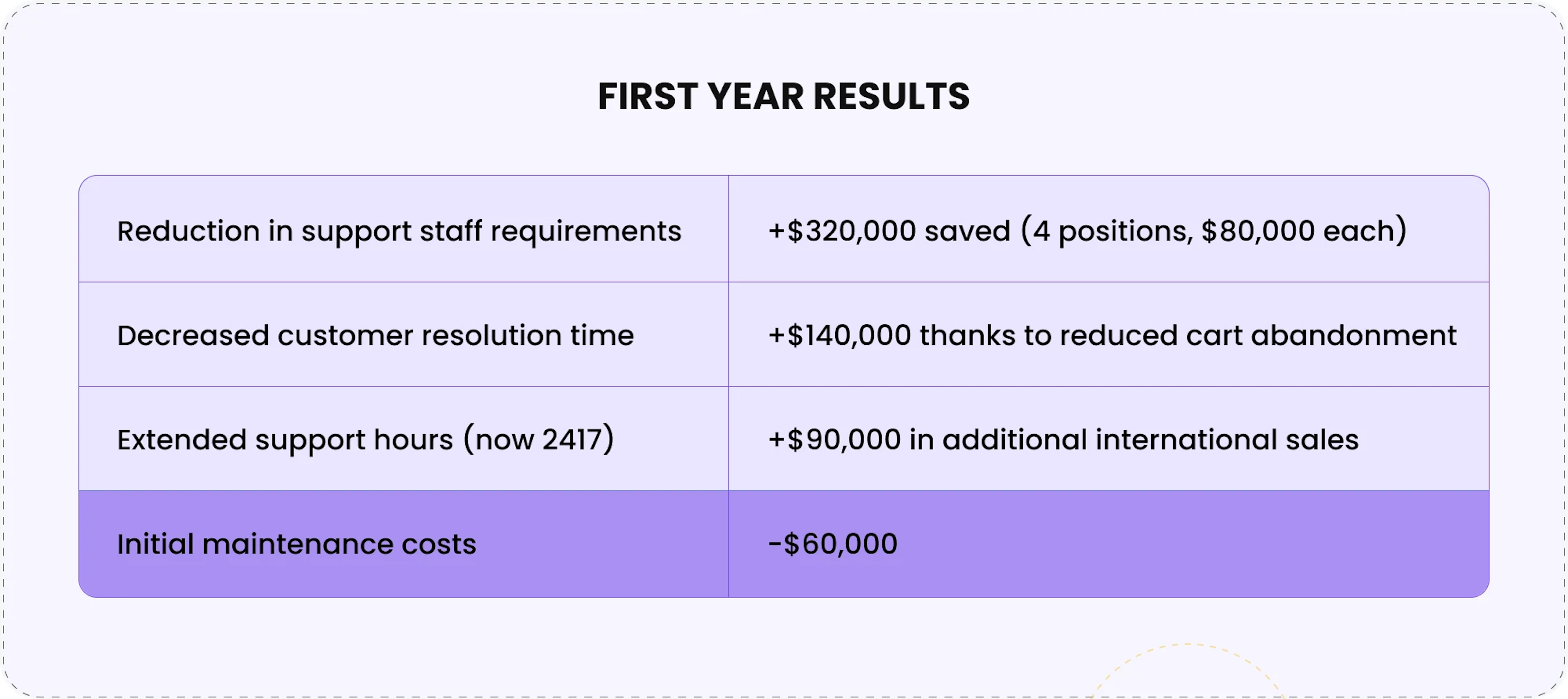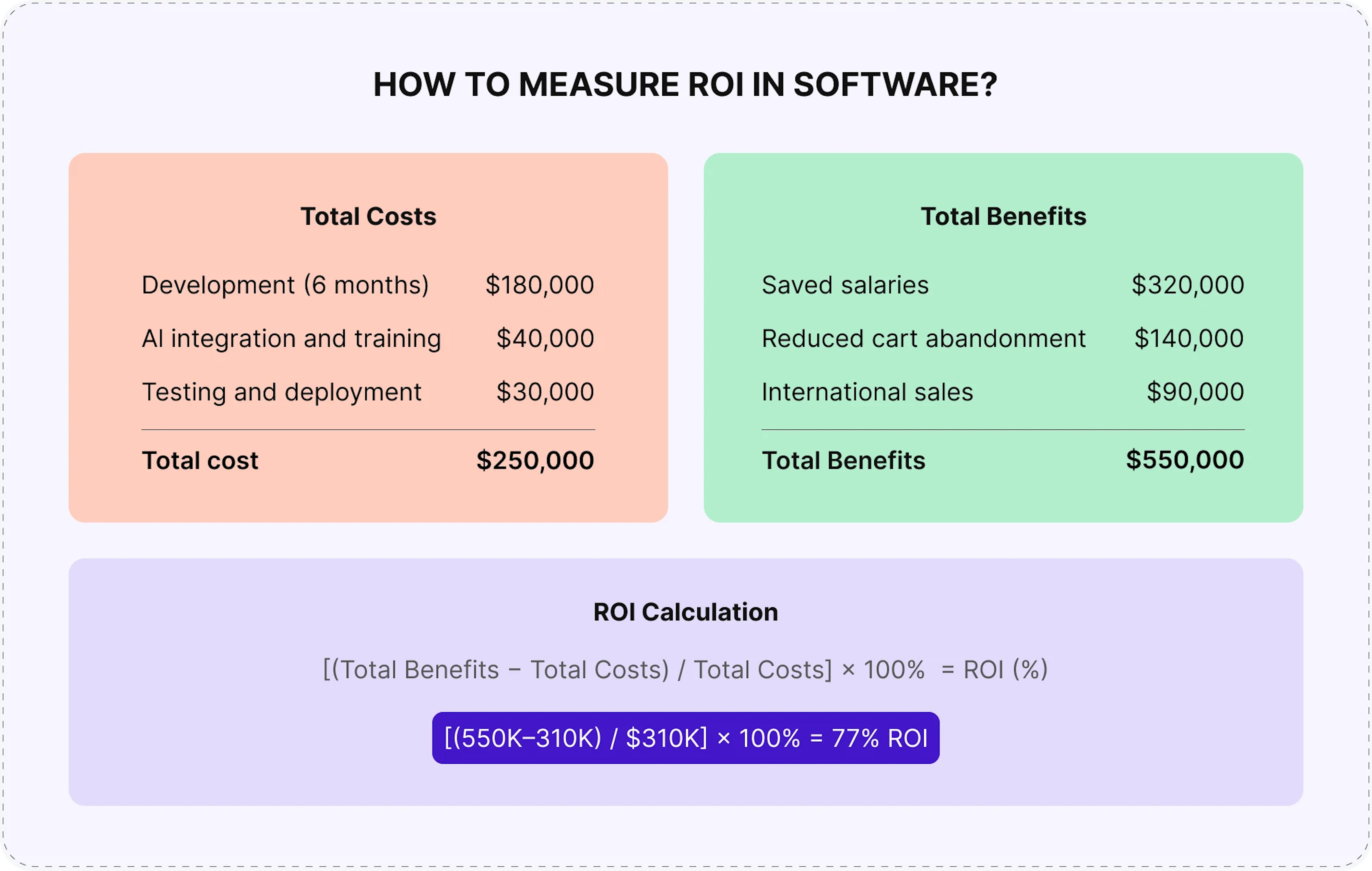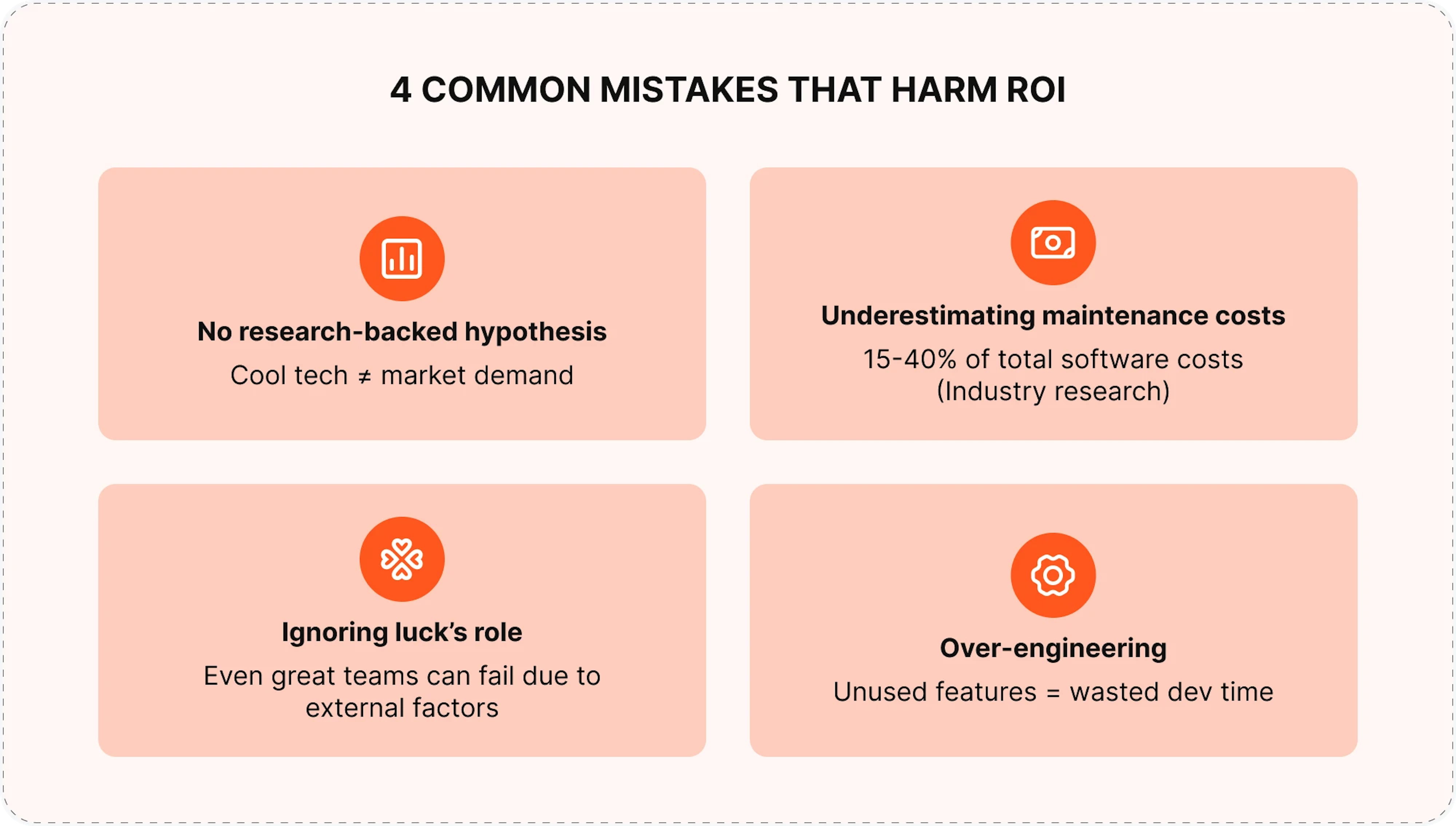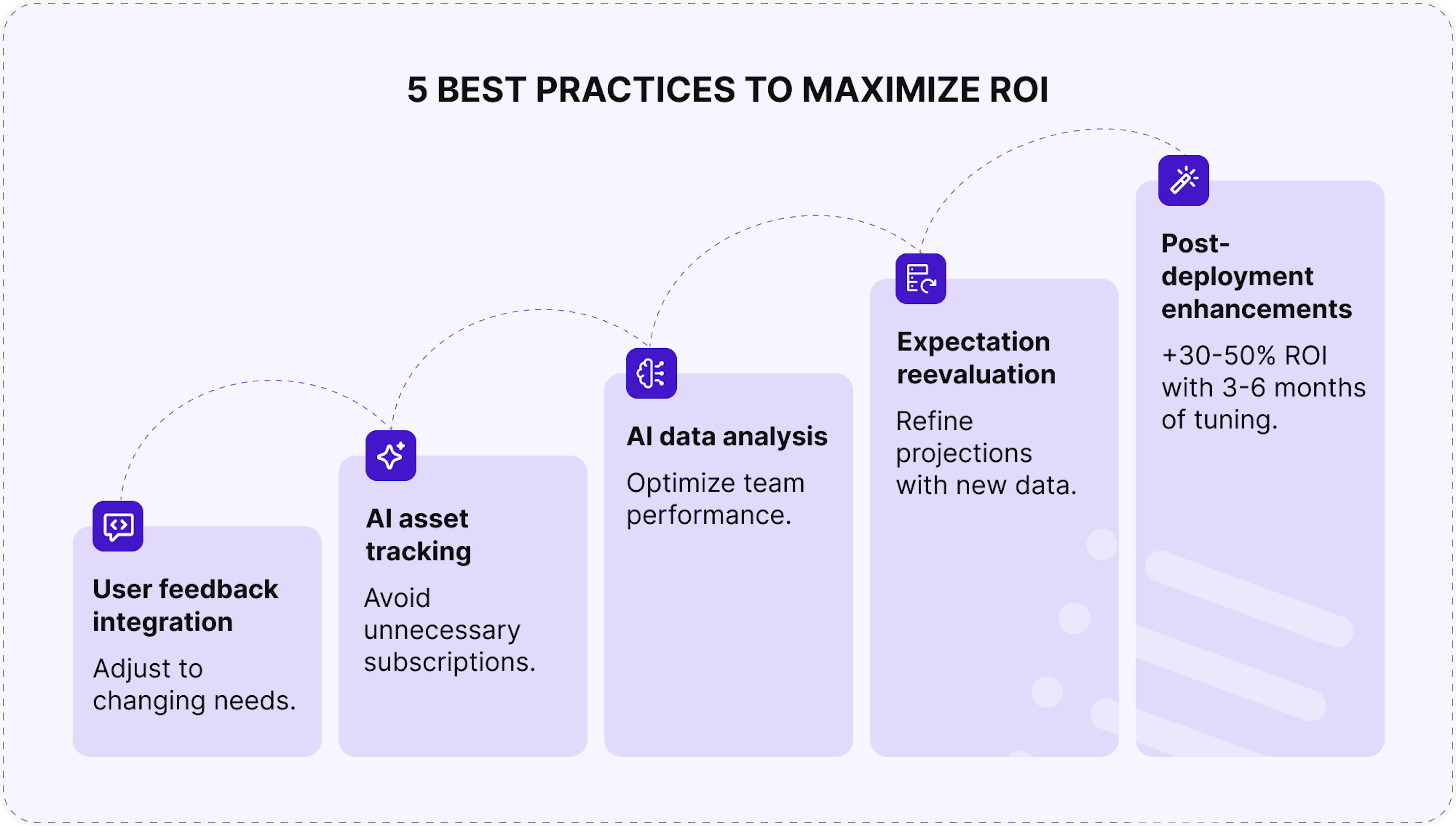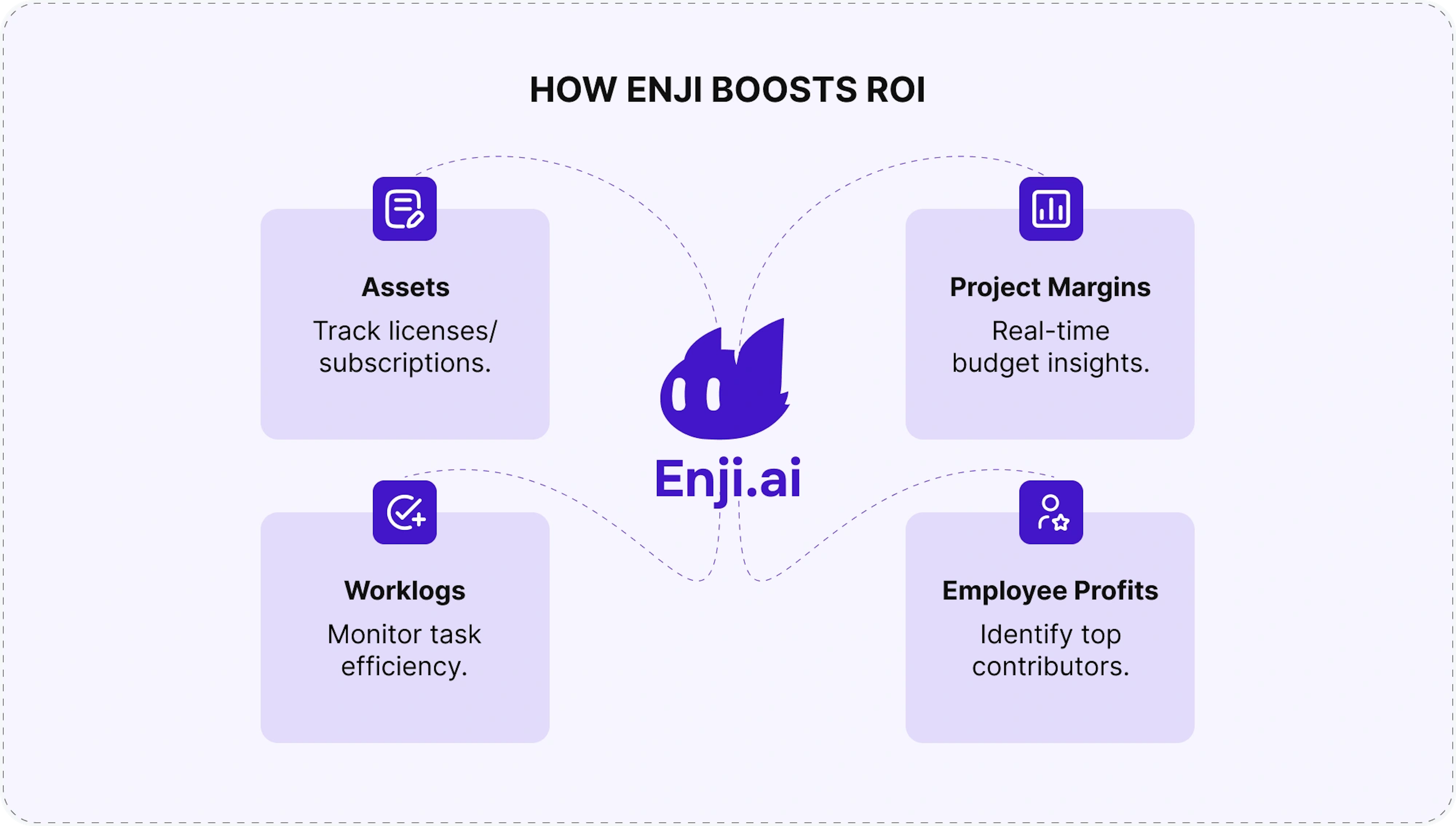How to Measure Software Development ROI in 2025
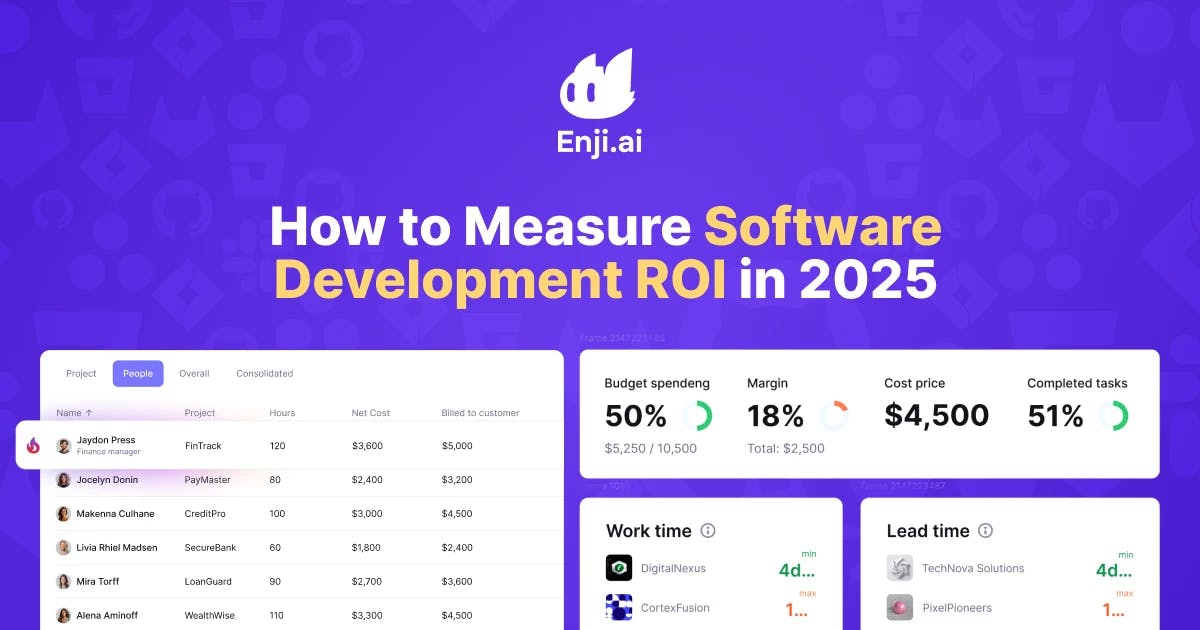
In the fast-changing world of software development, measurements of a business's return on investment (ROI) have become more complex, while remaining an essential ingredient of success. Companies face pressure to justify technology investments with tangible results while navigating diverse development methodologies, emerging technologies, and shifting market expectations.
This article explores the complex nature of software development ROI and offers a practical framework for measurement and optimization. Whether managing enterprise applications, building customer-facing products, or implementing internal tools, understanding how to accurately calculate and maximize the return on development investment is a part of an informed decision-making strategy. Beyond simple financial calculations, this analysis examines both hard and soft returns, common pitfalls that undermine potential value, and actionable steps to enhance ROI throughout the software development lifecycle.
ROI and its role in software development
To understand how to measure and improve ROI, it is important to first examine the two different types of return a business can receive from an investment: hard and soft. ROI in software development is not always about the amount of money that appears in a company's account in a given period of time. Other factors are valuable and can lead to more opportunities in the future.
Hard ROI
This is money. For example, if investors give a startup $1,000,000, they expect this amount (or more) back in a relatively short amount of time. Another way to view hard ROI is as a new feature to an app that a company develops and which is only available through a higher-tier subscription. As a result, the business receives an increase in revenue.
Soft ROI
Connected with a business's image and reputation. If, in the example of the new feature, the company does not increase its revenue, it may still win if the feature proves to be unique. They now have a case and expertise they can demonstrate to investors to argue for more resources in the future. The company may also show a commitment to user feedback or other important aspects. This type of return is helpful from a long-term perspective.
With these distinctions, there are situations when a company earns both hard and soft ROI. If it delivers a successful product and increases revenue, customers and other stakeholders will feel more trust in the business and loyalty to its products. The opposite can be true as well, because more revenue does not necessarily indicate that the product or service works well or is designed properly. A company can achieve a good hard ROI but see little results on the soft side.
What is a good software ROI?
In terms of hard ROI, there is no single answer to this question. In a more general sense, a good ROI, whether soft or hard, in software development varies by context and the type of company involved. For example, an established enterprise company with a strong reputation, such as Apple, may focus more on revenue and less on proving its ability to create a strong product, while a newer business may benefit more from a boost to its soft ROI rather than a high profit.
Still, there are some numbers to use as benchmarks. For example, iSixSigma considers 5-10% to be a good return, while ClearPoint Strategy cites 20% as a good target. Any returns above these numbers will indicate much clearer success, and returns of 100% or more, of course, mean that an investment has paid for itself. The key to understanding "good" in this context is to connect expectations with the reality of a project. For example, custom software solutions may require higher investment and risk, though they have a greater chance of delivering improvements to business processes or creating new streams of revenue. In a similar way, a project that promises significant changes or enhancements to existing processes or activities will generate expectations for a larger ROI.
As mentioned above, returns can also be intangible. A company that creates an interesting and valuable product or solution increases its reputation, which can lead to more profitable opportunities in the future. Successful businesses look beyond immediate financial returns to consider how software investments align with their long-term business objectives. That means that they need to consider how to measure potential returns.
How to measure ROI in software?
Whether hard or soft, the concept of ROI emphasises the "return" part of the formula that a company receives. That makes sense, given that it is the easiest element to calculate. Money appears in an account, and that is all. Or, a company or team members receive an award or acknowledgment. In either case, there is a result that can be demonstrated to the public or investors. However, the key to an accurate ROI calculation is not how to count revenue, but rather the art of measuring expenses. Successful business leaders recognize the importance of all project expenses. This is 80% of the task.
If a company ignores its spending, the budget can burn out faster than expected. Particular expenses that can remain unnoticed include:
- Employee salary vs profit: An engineer may receive $50/hour for their work on a project, but they cost the company $60/hour.
- Time spent on tasks: Connected to the first point, a team may complete a project and deliver the expected results, but the time may have exceeded expectations, increasing the price.
- Overhead and assets: Companies require licenses, cloud infrastructure, service subscriptions, and other expenses to complete projects and keep their systems running. Without reviews, companies may be spending money on an unnecessary tool.
Business leaders who lack visibility into their company's expenses may encounter one of these problems:
- Their company is burning money, and they do not know where it is going.
- Their company is burning money, but they think expenses are smaller than they actually.
Both situations are damaging to ROI and hint at a key problem: a lack of data. If responsible stakeholders lack sufficient knowledge about the expenses associated with a project, the consequences can be damaging. A product or solution may be successful among users, but poor management of time and overhead can reduce its impact and lead to ultimate failure instead of higher revenue.
An example with a customer support automation project
Imagine a mid-sized e-commerce company that has experienced drops in sales due to poor responses to customer requests throughout their journey on the platform. The company also misses opportunities to expand to markets in other time zones due to a lack of staff who are available at unusual hours. Research has led them to develop a hypothesis that an AI-powered customer support chatbot can deliver greater reach and support. Here is the initial investment they made:
After the company implemented the chatbot, they observed the following results over the course of a year:
The results demonstrate both cost savings (reduced staff expenses) and extra revenue (more sales) as benefits. There are also some costs associated with maintaining the new system. Here is a summary of the benefits and costs:
- Total benefits: $550,000 ($320,000 + $140,000 + $90,000)
- Total costs: $310,000 ($250,000 + $60,000)
The company's net return is Total benefits − Total costs, or $550,000 − $310,000 = $240,000.
As a basic example, the company would use this information in the ROI formula for software projects:
ROI (%) = [(Total Benefits − Total Costs) / Total Costs] × 100%
Total benefits represent the sum of all quantifiable gains in this project, while total costs reflect all the expenses associated with the project.
$240,000 / $310,000 × 100% = 77%
This calculation represents first-year ROI. For more complex projects, businesses often calculate cumulative ROI across multiple years or determine the project's payback period (the time required to recover the initial investment).
There are more complex metrics for returns that businesses can use, such as total cost of ownership (TCO), implementation costs, time to value, associated risks, and return on time saved. For the chatbot investment, the e-commerce company will consider the following:
- Total cost of ownership (TCO): Reflects the true investment and includes all expenses throughout the chatbot's lifecycle in addition to the initial investment. Examples include maintenance, AI retraining, infrastructure, monitoring, and upgrades.
- Implementation cost: This refers to the upfront investment of $250,000 required before any benefits can materialize, as well as hidden costs such as business analyst time and staff training.
- Time to value: The time required to see any returns from the chatbot investment. In this example. The company measured results after a year, so that could be the time to evaluate.
- Risks associated: Risks with the chatbot include customer adoption concerns, performance limitations, and integration challenges with existing systems. These factors could reduce effectiveness and threaten the first-year ROI if not properly managed.
- Return on time saved: Time savings that create additional benefits, such as improved customer satisfaction and allowing staff to focus on higher-value work. The chatbot saved approximately 2,000 transactions worth $140,000 that would have been abandoned due to slow responses, as well as 13,300 customer service hours valued at $320,000.
Some of these metrics refer to costs that cannot be adjusted, such as the initial investment, while others can be reduced through optimization, such as maintenance costs. It is also important to consider the ROI in this example in terms of the timeframe. The initial increase in revenue reflects the results of one year, during which the business resolved issues, such as cart abandonment. The following year, that number may decrease; however, optimization can lead to more revenue, and the 24/7 work schedule of the chatbot can deliver more customers. These are examples of hard ROI. The final point, though, connects with the concept of soft ROI, since the company experiences improvements in responsiveness to customer complaints and questions. Overall, this e-commerce business is enjoying good hard and soft returns on its chatbot investment, because it did not rush into development. Nevertheless, there are lessons that other businesses can learn from to improve ROI instead of harming it.
4 common mistakes that harm ROI
In some ways, a business lays the foundation for a good ROI before the release of its product or solution. The wrong mindset or assumption can point resources in the wrong direction and lead to unrealized potential or a low and even non-existent ROI.
- No research-backed hypothesis
The coolest tech or best-designed product will not deliver a high return if there is no market for it. Likewise, this data can inform teams on how to market and sell their solution even if there seems to be a lack of interest. Businesses can increase the chance of a desirable ROI through a well-planned and executed approach to creating the initial hypothesis on which the project will be built. - Ignoring the role of luck in success
Strong market research and an impressive team with motivation may increase the chances of a strong ROI; however, any startup or project involves an element of luck. Unexpected events or more successful competitors can cancel out the advantages a new business brings to a market. Leaders can accept luck's role and press forward with the factors that remain under their control. - Underestimating maintenance costs
Many organizations focus primarily on development costs when calculating ROI and fail to account for true long-term maintenance expenses. Industry research indicates maintenance typically consumes 15-40% of a software product's total lifetime cost. This oversight leads to inflated ROI projections that cannot be sustained as tasks and work connected with maintenance accumulate over time. - Over-engineering solutions beyond business requirements
Teams may want to build functionality that exceeds a business's needs. While from a technical point of view, the new development may seem exciting, it creates new testing and maintenance demands, which add time and materials to the overall cost of development. Instead, teams need to ensure that solutions align with business objectives, unless an agreement is made to attempt something new.
Avoiding these mistakes is part of a strategy to increase the chances of high returns, and while luck has a role to play, there are steps companies can take to create a safeguard against misfortune.
5 best practices to maximize ROI
As noted above, there are different understandings of a "good" ROI; however, any business aims to make it better. If expenses are at the heart of an ROI calculation, then there are 5 best practices that leaders can follow to ensure their company stays on track to achieve its goals, including reputation and revenue.
1. Implement user feedback into development
Professional market research is the foundation of moving a business toward a good ROI, though it is not the only evaluation that a team needs to do. Situations and contexts change, and businesses should invest time and resources into understanding their target audience throughout the development process. Maybe their needs change, and the product can be adjusted to meet new expectations, or a feature may become irrelevant. Continuous feedback from users will ensure that a product or solution finds a fit in the market.
2. Monitor and track assets with AI tools
Subscriptions and other expenses can be lost in the routine of larger tasks and strategies. Unfortunately, this does not reduce their impact on a company's resources. Regular reviews of assets and their costs keep business leaders informed of smaller expenses that grow over time and give them the opportunity to remove unnecessary assets or upgrade plans.
3. Apply AI data analysis to identify optimization opportunities
Teams create an incredible amount of data related to their performance. In terms of software development teams, this refers to the amount of time it takes tasks to move from their initial status to completion, the quality of an individual engineer's code, and the efficiency of a team's overall process. Every bit of information is a signal for high or low performance that businesses can use to make adjustments that reduce unnecessary costs and boost productivity.
4. Perform regular reevaluation of expectations
As a product is under development, it is useful to return to initial projects and assumptions to refine them given new data and, if available, feedback. This helps businesses create more accurate predictions.
5. Build post-deployment enhancements into the project lifecycle
A business can improve its software ROI after initial deployment through enhancements. This includes a 3-6 month period during which the team focuses on performance tuning, workflow refinements, and addressing user feedback. Doing this may reveal ideas that were not obvious during development. Studies show that properly executed optimization phases can improve initial ROI figures by 30-50% through reduced maintenance costs and increased user effectiveness.
These best practices combine cultural and technological changes to a business's workflow that support an ROI-positive direction. To increase the chance of success, companies can harness the power of AI performance-boosting platforms. They feature tools that automate optimization and monitoring, which in turn lead to timely recognition of issues that may have a negative impact on development.
Enji supports a good ROI
AI platforms such as Enji.ai help businesses reduce unnecessary expenses throughout development to remain lean and reach a desirable ROI. Enji's features ensure that teams know what assets they are using and why, the real-time cost of development for features and products, and the contributions of individual team members.
- Assets: Tracks subscriptions and licenses to keep stakeholders informed and ensure that all assets remain up-to-date and do not burn through a budget.
- Worklogs: Stakeholders monitor time and use it to understand how engineers work on tasks. Helps identify inconsistencies or errors in priority management.
- Project margins: AI-powered analysis of a project's real-time margin based on expenses, team costs, and other data. Reduces budget surprises.
- Employee profits: Shows which team members contribute the most to a project and who can help deliver the best margin.
These features remove the walls around the "black box" of engineering to give all stakeholders, from clients to managers, the information they need to maximize their returns and improve performance. Even if a project does not deliver the expected revenue, Enji helps teams achieve higher levels of efficiency and an optimized workflow. With this "soft" ROI, they will be able to make the necessary changes that will increase the chances of success on new projects.
Harnessing an ROI-positive mindset
As software continues to transform industries and drive business innovation, the ability to measure and optimize development ROI with accuracy remains a critical competitive advantage. The most successful businesses recognize that software investment returns extend beyond immediate financial metrics to include customer satisfaction, organizational efficiency, and strategic positioning. By avoiding common pitfalls such as inadequate research, underestimated maintenance costs, and over-engineering, teams can significantly improve project outcomes.
The 5 best practices outlined in this article create a foundation for sustainable ROI improvement that encourages companies to view returns as more than a one-time calculation. It is an ongoing process of evaluation and optimization throughout the software lifecycle that will ensure technology investments deliver meaningful business value in an increasingly competitive digital landscape. Enji.ai is available to support businesses that want more out of their teams and to build sustainable ROI practices.

